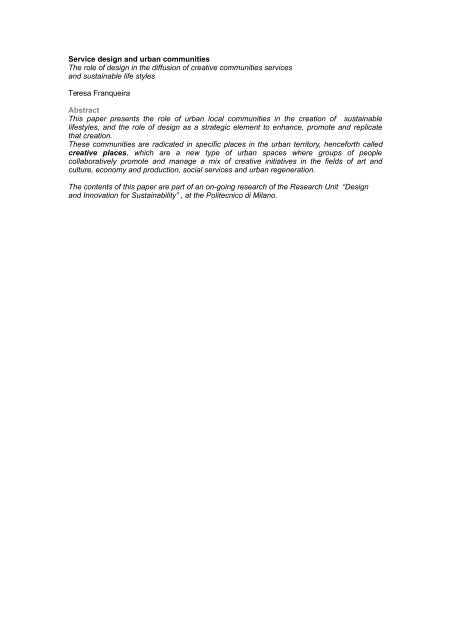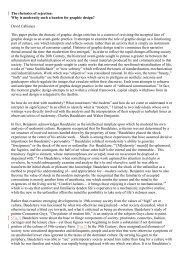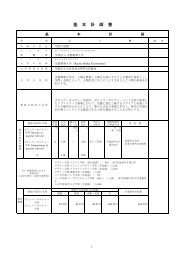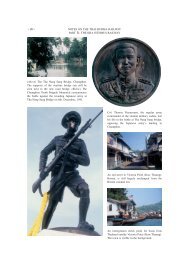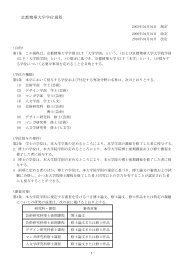Service design and urban communities The role of design in the
Service design and urban communities The role of design in the
Service design and urban communities The role of design in the
You also want an ePaper? Increase the reach of your titles
YUMPU automatically turns print PDFs into web optimized ePapers that Google loves.
<strong>Service</strong> <strong>design</strong> <strong>and</strong> <strong>urban</strong> <strong>communities</strong><br />
<strong>The</strong> <strong>role</strong> <strong>of</strong> <strong>design</strong> <strong>in</strong> <strong>the</strong> diffusion <strong>of</strong> creative <strong>communities</strong> services<br />
<strong>and</strong> susta<strong>in</strong>able life styles<br />
Teresa Franqueira<br />
Abstract<br />
This paper presents <strong>the</strong> <strong>role</strong> <strong>of</strong> <strong>urban</strong> local <strong>communities</strong> <strong>in</strong> <strong>the</strong> creation <strong>of</strong> susta<strong>in</strong>able<br />
lifestyles, <strong>and</strong> <strong>the</strong> <strong>role</strong> <strong>of</strong> <strong>design</strong> as a strategic element to enhance, promote <strong>and</strong> replicate<br />
that creation.<br />
<strong>The</strong>se <strong>communities</strong> are radicated <strong>in</strong> specific places <strong>in</strong> <strong>the</strong> <strong>urban</strong> territory, henceforth called<br />
creative places, which are a new type <strong>of</strong> <strong>urban</strong> spaces where groups <strong>of</strong> people<br />
collaboratively promote <strong>and</strong> manage a mix <strong>of</strong> creative <strong>in</strong>itiatives <strong>in</strong> <strong>the</strong> fields <strong>of</strong> art <strong>and</strong><br />
culture, economy <strong>and</strong> production, social services <strong>and</strong> <strong>urban</strong> regeneration.<br />
<strong>The</strong> contents <strong>of</strong> this paper are part <strong>of</strong> an on-go<strong>in</strong>g research <strong>of</strong> <strong>the</strong> Research Unit “Design<br />
<strong>and</strong> Innovation for Susta<strong>in</strong>ability” , at <strong>the</strong> Politecnico di Milano.
Introduction<br />
A desirable change<br />
<strong>The</strong> world is <strong>in</strong> a cont<strong>in</strong>uous <strong>and</strong> fastpaced change, whe<strong>the</strong>r we consider environmental,<br />
technological or economic transformations, or, even more significantly, whe<strong>the</strong>r we look at <strong>the</strong><br />
social ones. Most appear as positive, however some br<strong>in</strong>g about some problems.<br />
Great <strong>urban</strong> concentrations br<strong>in</strong>g about cultural, social <strong>and</strong> relational diversity, which, <strong>in</strong> turn<br />
dem<strong>and</strong> transformations <strong>in</strong> <strong>the</strong> territory <strong>the</strong>y exist. <strong>The</strong> lack <strong>of</strong> policies adjusted to those<br />
transformations <strong>and</strong> <strong>the</strong> need to adapt <strong>and</strong> develop systems able to structure <strong>the</strong> social <strong>and</strong><br />
relational fabric <strong>of</strong> cities have given birth to a phenomenon <strong>of</strong> collaborative <strong>communities</strong> <strong>in</strong><br />
which <strong>in</strong>dividuals collaborate between <strong>the</strong>m, thus promot<strong>in</strong>g an active citizenship, <strong>in</strong> contrast<br />
with a certa<strong>in</strong> passivity widespread <strong>in</strong> contemporary society.<br />
<strong>The</strong>se <strong>communities</strong> reveal <strong>the</strong>mselves through different activities, but for <strong>the</strong> purpose <strong>of</strong> <strong>the</strong><br />
research it will be focuss<strong>in</strong>g <strong>in</strong> <strong>the</strong> ones which are <strong>the</strong> <strong>the</strong> manifestation <strong>of</strong> two key research<br />
<strong>and</strong> policy doma<strong>in</strong>s: creative <strong>in</strong>dustries (Gibbons, 1994; Florida 2002 <strong>and</strong> 2004; Caves, 2000)<br />
<strong>and</strong> creative <strong>communities</strong> (Manz<strong>in</strong>i <strong>and</strong> Jegou, 2003; EMUDE, 2006; Meroni, 2007).<br />
In parallel, <strong>the</strong>re is discussion about old ex-<strong>in</strong>dustrial areas <strong>and</strong> <strong>the</strong>ir potential for susta<strong>in</strong>able<br />
<strong>urban</strong> development. In fact, <strong>in</strong> <strong>the</strong> late 20th century <strong>the</strong> majority <strong>of</strong> European cities have seen<br />
many symbolic l<strong>and</strong>marks <strong>of</strong> <strong>in</strong>dustrial, merchant <strong>and</strong> military activity be<strong>in</strong>g ab<strong>and</strong>oned <strong>and</strong><br />
fell <strong>in</strong>to disuse. <strong>The</strong> passage from a period <strong>of</strong> <strong>in</strong>dustrial prosperity (active production) to<br />
ano<strong>the</strong>r that disfigured entire areas <strong>and</strong> made many <strong>of</strong> <strong>the</strong>ir <strong>in</strong>habitants jobless has<br />
transformed <strong>the</strong> surround<strong>in</strong>g area also <strong>in</strong> ab<strong>and</strong>oned places. But, this reality also opened<br />
unforeseen perspectives as some <strong>of</strong> <strong>the</strong>se ab<strong>and</strong>oned places were re-occupied, were<br />
converted to new uses <strong>and</strong> gradually began a new life.<br />
<strong>The</strong> many dimensions <strong>of</strong> <strong>the</strong>se places <strong>and</strong> <strong>the</strong>ir spirit <strong>of</strong> <strong>in</strong>dependence with regard to <strong>the</strong><br />
market <strong>and</strong> politics, have brought <strong>in</strong>to be<strong>in</strong>g a new generation <strong>of</strong> cultural venues.<br />
<strong>The</strong>se new cultural venues upgrade <strong>the</strong> <strong>urban</strong> environment <strong>of</strong> entire neighbourhoods. <strong>The</strong>y<br />
encourage people to get <strong>in</strong>volved <strong>in</strong> civic <strong>in</strong>itiatives <strong>and</strong> to get toge<strong>the</strong>r to back common<br />
causes, <strong>the</strong>y provide emotional <strong>and</strong> <strong>in</strong>tellectual outlets <strong>in</strong> creation, <strong>and</strong> <strong>in</strong> do<strong>in</strong>g so <strong>the</strong>y help<br />
people to form a better relationship with <strong>the</strong>ir environment <strong>and</strong> <strong>the</strong>ir lives.<br />
In <strong>the</strong> framework <strong>of</strong> this debate, <strong>the</strong> ongo<strong>in</strong>g research <strong>in</strong>tends to explore Creative Places’<br />
economic, cultural <strong>and</strong> social <strong>role</strong> with<strong>in</strong> contemporary cities, <strong>in</strong>vestigat<strong>in</strong>g how <strong>the</strong>y actually<br />
manage to reconcile economic <strong>and</strong> cultural development with <strong>the</strong> regeneration <strong>of</strong> citizenship<br />
<strong>and</strong> identity. More particularly, to explore <strong>the</strong> potential <strong>of</strong> Creative Places <strong>in</strong> order to propose a<br />
strategic plan <strong>and</strong> <strong>design</strong> tools that support <strong>urban</strong> regeneration processes <strong>and</strong> allow Creative<br />
Places to <strong>in</strong>tegrate <strong>the</strong>ir physical, social, cultural <strong>and</strong> environmental dimensions.<br />
State <strong>of</strong> <strong>the</strong> art<br />
...city<br />
Cities <strong>in</strong>cubate new bus<strong>in</strong>esses, connect people, ideas, money <strong>and</strong> markets <strong>and</strong> house most<br />
universities. In our <strong>in</strong>creas<strong>in</strong>gly diverse society <strong>the</strong>y are <strong>the</strong> crucibles for connect<strong>in</strong>g cultures<br />
<strong>and</strong> generat<strong>in</strong>g opportunity.<br />
In recent years creativity has been <strong>in</strong>troduced <strong>in</strong> economic <strong>and</strong> <strong>urban</strong> policies as a key<br />
resource to compete <strong>in</strong> <strong>the</strong> global knowledge economy. Many creative city strategies have<br />
focused on provid<strong>in</strong>g <strong>the</strong> spaces - physical <strong>and</strong> social environments – to stimulate <strong>the</strong><br />
production <strong>of</strong> creative contents <strong>and</strong> <strong>communities</strong>, <strong>the</strong> start up <strong>of</strong> value added economic<br />
activities <strong>and</strong> <strong>the</strong> regeneration <strong>of</strong> degraded <strong>urban</strong> areas [Creative London, 2005]. On closer<br />
exam<strong>in</strong>ation most <strong>of</strong> <strong>the</strong>se city strategies have been actually concerned with streng<strong>the</strong>n<strong>in</strong>g<br />
<strong>the</strong> arts <strong>and</strong> cultural fabric <strong>and</strong>/or foster<strong>in</strong>g <strong>the</strong> creative <strong>in</strong>dustries (L<strong>and</strong>ry, 2005) which have<br />
<strong>the</strong> potential for wealth <strong>and</strong> job creation through <strong>the</strong> generation <strong>and</strong> exploitation <strong>of</strong> <strong>in</strong>tellectual<br />
property (advertis<strong>in</strong>g, architecture, art, crafts, <strong>design</strong>, <strong>design</strong>er fashion, television, radio, film<br />
<strong>and</strong> video, <strong>in</strong>teractive leisure s<strong>of</strong>tware, music, <strong>the</strong> perform<strong>in</strong>g arts, publish<strong>in</strong>g <strong>and</strong> s<strong>of</strong>tware<br />
creation).<br />
CEOs for Cities 1 has def<strong>in</strong>ed <strong>the</strong> areas <strong>in</strong> most urgent need <strong>of</strong> fresh th<strong>in</strong>k<strong>in</strong>g <strong>in</strong> cities as: 1.<br />
<strong>The</strong> Talented City (Develop<strong>in</strong>g, maximiz<strong>in</strong>g, attract<strong>in</strong>g <strong>and</strong> reta<strong>in</strong><strong>in</strong>g talent); 2. <strong>The</strong> Innovative<br />
City (Foster<strong>in</strong>g <strong>in</strong>novation <strong>and</strong> entrepreneurship); 3. <strong>The</strong> Connected City (Foster<strong>in</strong>g<br />
connections that l<strong>in</strong>k people with ideas to talent, capital <strong>and</strong> markets; cities to regions; <strong>and</strong><br />
1 CEOs for Cities is a bipartisan, nonpr<strong>of</strong>it a lliance <strong>of</strong> US mayors, corporate executives, university<br />
presidents <strong>and</strong> nonpr<strong>of</strong>it le aders, that works with local <strong>and</strong> national policy-makers to advance <strong>the</strong><br />
economic competitiveness <strong>of</strong> cities.
egions to <strong>the</strong> global economy); <strong>and</strong> 4. <strong>The</strong> Dist<strong>in</strong>ctive City (Capitaliz<strong>in</strong>g on local differences<br />
to build local economic opportunity). <strong>The</strong>se dimensions make cities more competitives, but<br />
<strong>the</strong>se strategies have a strong economical dimension.<br />
Regard<strong>in</strong>g <strong>the</strong> social <strong>and</strong> susta<strong>in</strong>able dimension <strong>of</strong> cities it is possible to add <strong>the</strong><br />
Collaborative City, that is, a city with kernels <strong>of</strong> creativity, which are constituted by : social<br />
services, artistic <strong>and</strong> economic activities. This collaborative city is a place where people<br />
<strong>in</strong>teract <strong>and</strong> enact creat<strong>in</strong>g a symbiosis <strong>of</strong> activities that promote susta<strong>in</strong>able lifestyles, an<br />
active citizenship, social <strong>in</strong>clusion, cultural diversity <strong>and</strong> new economic models.<br />
It is a city where hierarchies are transversal <strong>in</strong>stead <strong>of</strong> vertical, i.e, where local authorities<br />
(<strong>urban</strong> leaders) create opportunities for mass participation, bottom-up creativity <strong>and</strong><br />
collaborative services.<br />
Creative….<br />
As referred <strong>in</strong> <strong>the</strong> abstract, creative places are a new type <strong>of</strong> <strong>urban</strong> spaces where groups <strong>of</strong><br />
people collaboratively promote <strong>and</strong> manage a mix <strong>of</strong> creative <strong>in</strong>itiatives <strong>in</strong> <strong>the</strong> fields <strong>of</strong> art <strong>and</strong><br />
culture, economy <strong>and</strong> production, social services <strong>and</strong> <strong>urban</strong> regeneration.<br />
<strong>The</strong>se creative <strong>in</strong>itiatives are elements <strong>of</strong> “creative <strong>in</strong>dustries” <strong>and</strong> “creative <strong>communities</strong>”,<br />
whose concepts are presented next.<br />
Creative <strong>in</strong>dustries<br />
Creativity forms <strong>the</strong> core activity <strong>of</strong> a grow<strong>in</strong>g part <strong>of</strong> today’s global economy — <strong>the</strong> so-called<br />
"creative <strong>in</strong>dustries" — generat<strong>in</strong>g wealth through <strong>the</strong> creation <strong>and</strong> exploitation <strong>of</strong> <strong>in</strong>tellectual<br />
property or through <strong>the</strong> supply <strong>of</strong> creative services. Creativity, <strong>and</strong> <strong>in</strong> particular <strong>the</strong> so called<br />
“creative class” (Florida 2002 <strong>and</strong> 2004; Florida <strong>and</strong> T<strong>in</strong>agli, 2004), are considered as a driver<br />
for <strong>the</strong> economic growth, be<strong>in</strong>g considered a strategic asset for improv<strong>in</strong>g competitiveness <strong>in</strong><br />
<strong>the</strong> knowledge based economy.<br />
<strong>The</strong>se considerations on <strong>the</strong> <strong>role</strong> <strong>of</strong> creativity <strong>in</strong> economic development are important but <strong>the</strong>y<br />
are too narrowly focused. First, <strong>urban</strong> regeneration has to be driven by democracy <strong>and</strong> citizen<br />
participation. This is as much a matter <strong>of</strong> everyday practice, as it is a matter <strong>of</strong> formal politics.<br />
Second, <strong>the</strong> fast chang<strong>in</strong>g knowledge societies <strong>of</strong> <strong>the</strong> 21st Century are characterised by a<br />
new k<strong>in</strong>d <strong>of</strong> creativity that connects different fields <strong>of</strong> action. That is, an extended creativity<br />
has widened its doma<strong>in</strong>, stretch<strong>in</strong>g from artistic to economic, social <strong>and</strong> environmental<br />
<strong>in</strong>itiatives. By pay<strong>in</strong>g attention to what is <strong>of</strong>ten taken for granted, as well as to <strong>the</strong> newly<br />
emerg<strong>in</strong>g diverse creative practices <strong>of</strong> participation, this research explores <strong>the</strong> concept <strong>of</strong><br />
extended creativity, connect<strong>in</strong>g economic issues with social, cultural <strong>and</strong> environmental ones.<br />
Creative <strong>communities</strong><br />
From previous European research (EMUDE, <strong>in</strong> particular) it emerged that <strong>the</strong>re exists a<br />
dynamic new form <strong>of</strong> creativity: a diffused creativity put co-operatively <strong>in</strong>to action by “nonspecialised”<br />
people, which takes shape as a significant expression <strong>of</strong> contemporary society.<br />
<strong>The</strong> EMUDE research has referred to <strong>the</strong>se enterpris<strong>in</strong>g people with <strong>the</strong> concept <strong>of</strong> creative<br />
<strong>communities</strong>. That is: groups <strong>of</strong> <strong>in</strong>novative citizens organis<strong>in</strong>g <strong>the</strong>mselves to solve a problem<br />
or to open new possibilities, <strong>and</strong> do<strong>in</strong>g so as a positive step <strong>in</strong> <strong>the</strong> social learn<strong>in</strong>g process<br />
towards social <strong>and</strong> environmental susta<strong>in</strong>ability (EMUDE, 2006; Meroni, 2007).<br />
Creative <strong>communities</strong> are very diverse <strong>in</strong> <strong>the</strong>ir nature <strong>and</strong> <strong>in</strong> <strong>the</strong> way <strong>the</strong>y operate. But <strong>the</strong>y<br />
have a highly mean<strong>in</strong>gful common denom<strong>in</strong>ator: <strong>the</strong>y are always <strong>the</strong> expression <strong>of</strong> radical<br />
<strong>in</strong>novations <strong>of</strong> local systems, i.e. discont<strong>in</strong>uities with regard to a given context, <strong>in</strong> <strong>the</strong> sense<br />
that <strong>the</strong>y challenge traditional ways <strong>of</strong> do<strong>in</strong>g th<strong>in</strong>gs <strong>and</strong> <strong>in</strong>troduce new, very different (<strong>and</strong><br />
<strong>of</strong>ten <strong>in</strong>tr<strong>in</strong>sically more susta<strong>in</strong>able) ones: e.g. organis<strong>in</strong>g advanced systems <strong>of</strong> shar<strong>in</strong>g space<br />
<strong>and</strong> equipment <strong>in</strong> places where <strong>in</strong>dividual use normally prevails; recover<strong>in</strong>g <strong>the</strong> quality <strong>of</strong><br />
healthy biological foods <strong>in</strong> areas where it is considered normal to <strong>in</strong>gest o<strong>the</strong>r types <strong>of</strong><br />
produce; develop<strong>in</strong>g systems <strong>of</strong> participative services <strong>in</strong> localities where <strong>the</strong>se services are<br />
usually provided with <strong>the</strong> assumption <strong>of</strong> absolute passivity on <strong>the</strong> part <strong>of</strong> users, etc.
a<br />
Cases<br />
To clarify what <strong>the</strong>se places are, how <strong>the</strong>y work, <strong>and</strong> what <strong>the</strong>y produce, a case study is<br />
presented.<br />
From <strong>the</strong> pre-analysis with a matrix 2 , <strong>the</strong> UfaFabrik case is one <strong>of</strong> <strong>the</strong> most “complete”.<br />
This matrix was devised to help visualise some cases, which after a prior analysis have<br />
proven to be <strong>the</strong> most pert<strong>in</strong>ent ones. <strong>The</strong>se cases' analysis is focussed, ma<strong>in</strong>ly, <strong>in</strong><br />
collaborative <strong>and</strong> social services be<strong>in</strong>g developed <strong>in</strong> those places. Complementarily, also <strong>the</strong><br />
cultural, environmental, economic <strong>and</strong> technological dimensions are analysed.<br />
Figure 1 presents <strong>the</strong> UfaFabric matrix <strong>in</strong>terpretation, <strong>in</strong> which <strong>the</strong> social, environmental <strong>and</strong><br />
cultural dimsensions are clearly identifiable.<br />
UfaFabrik. Berl<strong>in</strong>. Germany<br />
Figure 1 . UfaFabrik matrix<br />
Figure 2 . UfaFabrik<br />
Font: www.ufafabrik.de/<br />
<strong>The</strong> ufaFabrik is a one-<strong>of</strong>-a-k<strong>in</strong>d European experiment <strong>in</strong> community. What began <strong>in</strong> <strong>the</strong> 70's<br />
as a "squat" <strong>of</strong> <strong>the</strong> old Berl<strong>in</strong> Universal Studios led o <strong>the</strong> transformation <strong>of</strong> <strong>the</strong> build<strong>in</strong>gs <strong>and</strong><br />
extensive grounds <strong>in</strong>to a local artistic, social service <strong>and</strong> ecological centre. Many lower<br />
<strong>in</strong>come families liv<strong>in</strong>g nearby were <strong>in</strong>itially skeptical <strong>of</strong> <strong>the</strong> artists’ <strong>in</strong>tentions. But over time,<br />
this redevelopment process used <strong>the</strong> arts to engage, <strong>in</strong>clude <strong>and</strong> ultimately revitalise <strong>the</strong><br />
entire community.<br />
In 1979, West Berl<strong>in</strong> was one <strong>of</strong> <strong>the</strong> priciest cities <strong>in</strong> Europe <strong>and</strong> affordable hous<strong>in</strong>g was not<br />
readly available. Consequently, some <strong>in</strong>dividuals, resorted to squatt<strong>in</strong>g – <strong>the</strong> practice <strong>of</strong><br />
occupy<strong>in</strong>g <strong>and</strong> liv<strong>in</strong>g <strong>in</strong> ab<strong>and</strong>oned build<strong>in</strong>gs. One build<strong>in</strong>g taken over <strong>in</strong> this way was <strong>the</strong><br />
former Universal Studios film studio <strong>in</strong> Berl<strong>in</strong>. <strong>The</strong> studio, famous for many productions<br />
throughout <strong>the</strong> 30’s <strong>and</strong> 40’s, was ab<strong>and</strong>oned after <strong>the</strong> Second World. In 1979 a group <strong>of</strong><br />
young artists moved <strong>in</strong>to <strong>the</strong> dilapidated facility, shortly before <strong>the</strong> planned demolition <strong>of</strong> <strong>the</strong><br />
build<strong>in</strong>gs. This action was referred to as <strong>the</strong> "Big Post Robbery" as Universal Studios had sold<br />
<strong>the</strong> build<strong>in</strong>gs to <strong>the</strong> local post <strong>of</strong>fice.<br />
<strong>The</strong> grounds <strong>of</strong> <strong>the</strong> former UFA Film studios <strong>in</strong> Tempelh<strong>of</strong> are „peacefully re-activated“ on <strong>the</strong><br />
9th <strong>of</strong> June. A large banner was placed at <strong>the</strong> entrance read<strong>in</strong>g “Welcome” to <strong>in</strong>vite all <strong>of</strong><br />
those <strong>in</strong>terested to take part <strong>and</strong> to <strong>in</strong>terpret <strong>the</strong> plans <strong>of</strong> <strong>the</strong> activists for <strong>the</strong>mselves: a place,<br />
where <strong>the</strong> wide range <strong>of</strong> social spheres can be brought toge<strong>the</strong>r <strong>in</strong> a co-operative project. 45<br />
people decided to live toge<strong>the</strong>r <strong>in</strong> a resident community, shared <strong>the</strong>ir <strong>in</strong>come <strong>and</strong> took <strong>the</strong><br />
2<br />
In <strong>the</strong> fir st stage <strong>of</strong> research, <strong>the</strong> methodology used is based <strong>in</strong> case studies analysis.<br />
Initially, <strong>the</strong>se cases will be pre-selected based <strong>in</strong> a matrix. With <strong>the</strong> mapp<strong>in</strong>g, classifica tion<br />
<strong>and</strong> analysis <strong>of</strong> relevant cases, concern<strong>in</strong>g <strong>the</strong>ir social, cultural, technological, environmental<br />
<strong>and</strong> economical dimensions it is <strong>in</strong>tended to select 3 or 5 cases to be analysed <strong>in</strong> depth.
chance to build <strong>the</strong>ir own susta<strong>in</strong>able village <strong>in</strong> <strong>the</strong> metropolis Berl<strong>in</strong>. New ideas have been<br />
implemented at <strong>the</strong> ufaFabrik over <strong>the</strong> past 25 years, <strong>in</strong>volv<strong>in</strong>g ecology <strong>and</strong> susta<strong>in</strong>able<br />
development, <strong>the</strong> test<strong>in</strong>g <strong>of</strong> concepts for produc<strong>in</strong>g culture <strong>and</strong> approaches to social<br />
development <strong>and</strong> neighbourhood work.<br />
Today <strong>the</strong> activities <strong>of</strong> <strong>the</strong> 30 residents <strong>and</strong> over 150 co-workers cont<strong>in</strong>ue to be <strong>in</strong>formed by<br />
<strong>the</strong> vision <strong>of</strong> shap<strong>in</strong>g a mean<strong>in</strong>gful <strong>in</strong>tegration <strong>of</strong> liv<strong>in</strong>g <strong>and</strong> work<strong>in</strong>g with culture, creativity <strong>and</strong><br />
community. Currently <strong>the</strong> dimensions <strong>of</strong> programmes <strong>and</strong> activity at UfaFabrik <strong>in</strong>clude:<br />
_An International Culture Centre that <strong>of</strong>fers free space for performances.<br />
_<strong>The</strong> Neighbourhood <strong>and</strong> Self-Help Centre, provid<strong>in</strong>g assistance with social, health <strong>and</strong><br />
family matters. <strong>Service</strong>s <strong>in</strong>clude family care services, a day-care centre, ecology programmes<br />
for local school groups <strong>and</strong> a Medical Centre.<br />
_<strong>The</strong> Children’s Circus School committed to <strong>the</strong> development <strong>of</strong> talented young performers.<br />
_<strong>The</strong> grounds <strong>of</strong> <strong>the</strong> ufaFabrik rema<strong>in</strong> a green oasis with<strong>in</strong> <strong>the</strong> metropolis, <strong>and</strong> are home to a<br />
great variety <strong>of</strong> Ecology Projects comb<strong>in</strong><strong>in</strong>g food production <strong>and</strong> alternative energy systems.<br />
_A Children’s Farm,<br />
_A private school<br />
_In-house Organic Bakery , Natural Foods Store <strong>and</strong> Confectionery.<br />
_<strong>The</strong> Café Olé.<br />
Grote Pyr. Den Haag. Ne<strong>the</strong>rl<strong>and</strong>s<br />
Figure 3 . Grote Pyr matrix<br />
Figure 4 . Grote Pyr<br />
Font: www.grotepyr.nl/<br />
Grtote Pyr is a type <strong>of</strong> cohous<strong>in</strong>g that st<strong>and</strong>s <strong>in</strong> an 1900 school that was ab<strong>and</strong>oned for<br />
years.<br />
<strong>The</strong> Grote Pyr is <strong>the</strong> "<strong>of</strong>fspr<strong>in</strong>g" from <strong>the</strong> Blauwe Aanslag, a former tax <strong>of</strong>fice squatted <strong>in</strong><br />
1980, which was (forcefully) evicted <strong>in</strong> October 2003. <strong>The</strong> City <strong>of</strong> Den Haag <strong>of</strong>fered what is<br />
now <strong>the</strong> Grote Pyr for sale to <strong>the</strong> former <strong>in</strong>habitants <strong>of</strong> <strong>the</strong> Blauwe. S<strong>in</strong>ce 2002, <strong>the</strong><br />
<strong>in</strong>habitants <strong>and</strong> user-groups have been busy with <strong>the</strong> renovation <strong>of</strong> this monumental school
uild<strong>in</strong>g from 1907 <strong>in</strong>to an ecological freespace.<br />
<strong>The</strong> majority <strong>of</strong> <strong>the</strong> classrooms <strong>and</strong> <strong>the</strong> enormous attic are be<strong>in</strong>g modified <strong>in</strong>to liv<strong>in</strong>g <strong>and</strong><br />
work<strong>in</strong>g spaces.<br />
In this place, people cook <strong>and</strong> eat toge<strong>the</strong>r <strong>in</strong> <strong>the</strong> old school kitchen <strong>and</strong> each dwell<strong>in</strong>g is a<br />
classroom <strong>and</strong> <strong>the</strong> tenants <strong>of</strong> this special condom<strong>in</strong>ium do not share an address, <strong>the</strong>y share<br />
small <strong>and</strong> large pieces <strong>of</strong> life.<br />
<strong>The</strong>y meet toge<strong>the</strong>r once a month to discuss practical problems, to divide tasks <strong>and</strong> to<br />
monitor <strong>the</strong> works <strong>in</strong> <strong>the</strong> ro<strong>of</strong> <strong>and</strong> <strong>the</strong> management <strong>of</strong> <strong>the</strong> garden, among o<strong>the</strong>rs.<br />
<strong>The</strong>re are different activities <strong>in</strong> Grote Pyr, from cultural ones, to economic ones, like a studio<br />
<strong>of</strong> a blacksmith, ano<strong>the</strong>r one that constructs bicycles, a society <strong>of</strong> biologic cater<strong>in</strong>g, a bar, a<br />
museum where children can play with materials <strong>and</strong> science, exhibitions, events <strong>and</strong> lessons<br />
<strong>and</strong> a restaurant open to <strong>the</strong> public.<br />
Grote Pyr represents, for <strong>the</strong> city, a place <strong>of</strong> social susta<strong>in</strong>ability <strong>and</strong> a l<strong>in</strong>k between <strong>the</strong> centre<br />
<strong>and</strong> o<strong>the</strong>r zones.<br />
How to facilitate <strong>the</strong> implementation <strong>of</strong> creative places /creative <strong>communities</strong> <strong>in</strong> <strong>the</strong> <strong>urban</strong><br />
territory by means <strong>of</strong> service <strong>design</strong>?<br />
Design <strong>role</strong><br />
One <strong>of</strong> <strong>the</strong> ways to achieve a susta<strong>in</strong>able future may be by promot<strong>in</strong>g <strong>the</strong> services developed<br />
by <strong>the</strong>se <strong>communities</strong>, <strong>and</strong> reproduc<strong>in</strong>g <strong>the</strong>m.<br />
This should be <strong>the</strong> <strong>design</strong>er’s sphere <strong>of</strong> action, <strong>and</strong> <strong>the</strong> opportunities for Design to <strong>in</strong>tervene<br />
are located at three levels: promotion <strong>and</strong> diffusion; enhancement; <strong>and</strong> facilitation <strong>of</strong> <strong>the</strong><br />
reproduction process.<br />
Promotion <strong>and</strong> diffusion<br />
At this level, Design can work as a communication tool, promot<strong>in</strong>g <strong>the</strong> cases attractively <strong>and</strong><br />
facilitat<strong>in</strong>g communication between <strong>the</strong> different knots <strong>of</strong> <strong>the</strong> network, i.e., rais<strong>in</strong>g <strong>the</strong> pr<strong>of</strong>ile <strong>of</strong><br />
<strong>the</strong>se <strong>in</strong>novation forms <strong>and</strong> <strong>the</strong> services <strong>the</strong>y provide.<br />
Enhancement<br />
Design can work as a mediator between <strong>the</strong> diverse actors (government entities,<br />
<strong>communities</strong>, <strong>and</strong> society at large) <strong>and</strong> as an enhancer <strong>of</strong> processes, be<strong>in</strong>g also responsible<br />
for <strong>design</strong><strong>in</strong>g possible scenarios that bridge creative people’s visions <strong>and</strong> <strong>the</strong> visions <strong>of</strong><br />
government entities that could help fulfill <strong>the</strong>ir ideas with material support.<br />
In this context, Design is <strong>the</strong> <strong>in</strong>terface not between <strong>the</strong> object <strong>and</strong> <strong>the</strong> user, but between <strong>the</strong><br />
service <strong>and</strong> its users/promoters.<br />
Reproduction<br />
This is <strong>the</strong> level that represents <strong>the</strong> biggest challenge, as it entails <strong>the</strong> <strong>design</strong> <strong>of</strong> tools<br />
necessary to make social <strong>in</strong>novations reproducible. Accord<strong>in</strong>g to Ezio Manz<strong>in</strong>i, this process<br />
consists <strong>in</strong> <strong>the</strong> conception <strong>of</strong> an enabl<strong>in</strong>g solution, that is, “a system that provides cognitive,<br />
technical <strong>and</strong> organisational <strong>in</strong>struments so as to enable <strong>in</strong>dividuals <strong>and</strong>/or <strong>communities</strong> to<br />
achieve a result, us<strong>in</strong>g <strong>the</strong>ir skills <strong>and</strong> abilities to <strong>the</strong> best advantage <strong>and</strong>, at <strong>the</strong> same time, to<br />
regenerate <strong>the</strong> quality <strong>of</strong> liv<strong>in</strong>g contexts, <strong>in</strong> which <strong>the</strong>y happen to live.” (2004)<br />
A Practical Work to be done….<br />
As said before, <strong>in</strong> <strong>the</strong> first stage <strong>of</strong> <strong>the</strong> research, <strong>the</strong> methodology used is based <strong>in</strong> case<br />
studies analysis whose aim is to create an <strong>in</strong>terpretative model that will lead to <strong>the</strong> second<br />
stage: an experimental work <strong>in</strong> Milan. <strong>The</strong> Milan district is propos<strong>in</strong>g a pilot project “Habitat e<br />
Cultura” for <strong>the</strong> creation <strong>of</strong> a multifunctional centre <strong>in</strong> <strong>the</strong> old milk factory <strong>of</strong> Locate. This<br />
centre will host a library, a cultural hall <strong>and</strong>, at <strong>the</strong> same time, <strong>the</strong> headquarters <strong>of</strong> 20<br />
associations from Locate di Triulzi. Depart<strong>in</strong>g from this specific project “Habitat e Cultura”,<br />
<strong>and</strong> draw<strong>in</strong>g on <strong>in</strong>ternational best practices identified through a comb<strong>in</strong>ation <strong>of</strong> desk <strong>and</strong> field<br />
research, <strong>the</strong> research will identify <strong>and</strong> develop optimal strategies for build<strong>in</strong>g <strong>the</strong> necessary<br />
<strong>in</strong>frastructure <strong>in</strong> which susta<strong>in</strong>able collaborative services can flourish.
This pratical work will be <strong>the</strong> creation <strong>of</strong> an enabl<strong>in</strong>g platform 3 to endow <strong>urban</strong> leaders with<br />
<strong>the</strong> appropriate technological, organizational, economic <strong>and</strong> legal systems.<br />
In <strong>the</strong> same way, it is <strong>in</strong>tended to create an enabl<strong>in</strong>g solution 4 (specific element) to endow<br />
<strong>the</strong>se <strong>communities</strong> with <strong>design</strong> tools to allow <strong>the</strong>m to set up <strong>the</strong>ire “creative place”.<br />
3<br />
An enabl<strong>in</strong>g platform is a set <strong>of</strong> material <strong>and</strong> immaterial elements that, implemented <strong>in</strong> a<br />
given context, enhances its potential to be a fertile ground for creative, bottom-up <strong>in</strong>itiatives.<br />
(Manz<strong>in</strong>i, Coll<strong>in</strong>a, Evans, 2004)<br />
4<br />
<strong>The</strong> specific elements <strong>of</strong> a solution are <strong>the</strong> components that make up a solution dedicated to<br />
a specific user group. On <strong>the</strong> contrary, <strong>the</strong> platform <strong>of</strong> a solution is constituted by <strong>the</strong><br />
components that are common to all <strong>the</strong> possible specific solutions.
Conclusions<br />
<strong>The</strong> vision <strong>of</strong> a possible city is based <strong>in</strong> <strong>the</strong> idea <strong>of</strong> a Collaborative City.<br />
In a closer look to this city, we discover its severals hubs, <strong>in</strong> particular places made <strong>of</strong> <strong>and</strong> by<br />
people, which work as creativity <strong>in</strong>cubators, laboratories <strong>of</strong> new cultural experiences, centres<br />
<strong>of</strong> social <strong>and</strong> solidary dynamism where new economic models are be<strong>in</strong>g forged.<br />
Places where people lead susta<strong>in</strong>able lifestyles, <strong>and</strong> from where <strong>the</strong>y are able to show to <strong>the</strong><br />
rema<strong>in</strong>der <strong>of</strong> society how traditional ways <strong>of</strong> life can be changed.<br />
Amongst <strong>the</strong> possible approaches to susta<strong>in</strong>able development, we give a special focus to <strong>the</strong><br />
<strong>design</strong> <strong>of</strong> services oriented towards new social models, <strong>in</strong> order to develop <strong>and</strong> streng<strong>the</strong>n<br />
cultural identities <strong>and</strong> susta<strong>in</strong>able lifestyles. In this sense, <strong>the</strong> <strong>in</strong>novation driven by <strong>design</strong><br />
operates with<strong>in</strong> an <strong>in</strong>tegrated system, with multidiscipl<strong>in</strong>ary teams that can help to build new<br />
social scenarios. <strong>The</strong>se scenarios presuppose new attitudes towards <strong>the</strong> unsusta<strong>in</strong>able<br />
patterns we adopted, imply<strong>in</strong>g new bus<strong>in</strong>ess strategies <strong>and</strong> new ways <strong>of</strong> promot<strong>in</strong>g quality <strong>of</strong><br />
life <strong>and</strong> well be<strong>in</strong>g.<br />
This scenario <strong>of</strong>fers <strong>design</strong> a different approach <strong>and</strong> a new opportunity to develop <strong>and</strong><br />
enhance a susta<strong>in</strong>able future.<br />
Design is about culture <strong>and</strong> creativity, is about problem solv<strong>in</strong>g, <strong>and</strong> <strong>the</strong>se “projects” are<br />
solv<strong>in</strong>g problems arisen from everyday activities that people have to carry out <strong>in</strong> this complex<br />
society.<br />
In <strong>the</strong>se framework <strong>design</strong> should act as an <strong>in</strong>terface between two levels (top-down <strong>and</strong><br />
bottom-up <strong>in</strong>itiatives), for top-down <strong>in</strong>itiatives are strategic whilst bottom-up ones are more<br />
tactical or operative. Design has <strong>the</strong> capacity <strong>of</strong> be<strong>in</strong>g both strategic <strong>and</strong> tactical, this means<br />
that <strong>design</strong> can potentiate people’s <strong>and</strong> government’s visions, creat<strong>in</strong>g scenarios accord<strong>in</strong>g to<br />
those same visions, benefit<strong>in</strong>g city life <strong>in</strong> mean<strong>in</strong>gful ways.
References<br />
Bauman, Zygmut, Voglia di comunità, Editori Laterza, Roma-Bari, 2001<br />
Bornste<strong>in</strong>, David (2004), How to change <strong>the</strong> world – social entrepreneurs <strong>and</strong> <strong>the</strong> power <strong>of</strong><br />
new ideas, Oxford University Press, New York<br />
Braungart, M., McDonough, A.(1998) <strong>in</strong> <strong>The</strong> Next Industrial Revolution, Atlantic<br />
Monthly, October; Volume 282, No. 4; 82-92<br />
British Council 2006. Facilitat<strong>in</strong>g Active Citizenship. E-participation <strong>in</strong> <strong>the</strong> United K<strong>in</strong>gdom <strong>and</strong><br />
Germany. A status report with examples from both countries. Prepared by pol-di.net e.V. /<br />
politik-digital.de<br />
Burgess, J., Foth, M. <strong>and</strong> Klaebe, H. (2006) Everyday Creativity as Civic Engagement: A<br />
Cultural Citizenship View <strong>of</strong> New Media. In Proceed<strong>in</strong>gs Communications Policy & Research<br />
Forum, Sydney.<br />
Castells M. (1996). <strong>The</strong> Rise <strong>of</strong> <strong>the</strong> Network Society. <strong>The</strong> Information Age: Economy, Society<br />
<strong>and</strong> Culture, vol. 1. Oxford: Blackwell (trad. it. 2002. La nascita della società <strong>in</strong> rete. Milano:<br />
EGEA).<br />
Caves, Richard E (2000) Creative Industries. Harvard University Press, Cambridge,<br />
Massachusetts <strong>and</strong> London<br />
Cottam, H., Leadbeater, 2004b. Open Welfare: <strong>design</strong>s on <strong>the</strong> public good, Design Council,<br />
London<br />
Creative London, Strategies for Creative Spaces. Phase 1 Report, September 2005<br />
Cunn<strong>in</strong>gham, Stuart (2001) From Cultural to Creative Industries: <strong>The</strong>ory, Industry, <strong>and</strong> Policy<br />
Implications, Creative Industries Research <strong>and</strong> Application Centre, Queensl<strong>and</strong> University <strong>of</strong><br />
Technology, Queensl<strong>and</strong><br />
Directorate-General for Research, European Commission, Future <strong>of</strong> Creative Industries<br />
Implications for Research Policy, by Carmen Marcus, Foresight Work<strong>in</strong>g Documents Series,<br />
EUR 21471, April 2005<br />
EMUDE (2006), Emerg<strong>in</strong>g User Dem<strong>and</strong>s for Susta<strong>in</strong>able Solutions, 6 th Framework<br />
Programme (priority 3-NMP), European Community, <strong>in</strong>ternal document<br />
European Parliament (2003), European Parliament Resolution on Cultural Industries,<br />
http://www.encatc.org/downloads/Report_Cultural_Industries.pdf<br />
Florida, R. <strong>and</strong> T<strong>in</strong>agli, I. (2004), Europe <strong>in</strong> <strong>the</strong> Creative Age, Pittsburgh, Carnegie Mellon<br />
S<strong>of</strong>tware Industry Center, Demos, London<br />
Florida, R. (2002 republished 2004), <strong>The</strong> rise <strong>of</strong> <strong>the</strong> creative class, Basic Books, New York<br />
Giddens, A., (1990) Consequences <strong>of</strong> Modernity. Polity Press, Cambridge<br />
Giddens, A., (1999) “Risk <strong>and</strong> Responsibility” Modern Law Review 62(1): 1-10.<br />
Giddens, Anthony (1999) – O Mundo na Era da Globalização, 3ª Edição, Lisboa, Editorial<br />
Presença, 2001<br />
Howk<strong>in</strong>s, John (2001) – <strong>The</strong> Creative Economy – How people make money from ideas,<br />
Pengu<strong>in</strong> Books, London<br />
L<strong>and</strong>ry, C.(2000), <strong>The</strong> Creative City: A Toolkit for Urban Innovators, Earthscan Publications<br />
Ltd, London
L<strong>and</strong>ry, C.( 2005), L<strong>in</strong>eages <strong>of</strong> <strong>the</strong> Creative City, <strong>in</strong> Simon Franke <strong>and</strong> Evert Verhagen (Ed.)<br />
Creativity <strong>and</strong> <strong>the</strong> City. How <strong>the</strong> creative economy is chang<strong>in</strong>g <strong>the</strong> city, NAI Publishers,<br />
Rotterdam<br />
L<strong>and</strong>ry, C., 2005, Age <strong>of</strong> <strong>the</strong> City - Creativity <strong>and</strong> <strong>the</strong> city<br />
http://www.charlesl<strong>and</strong>ry.com/<strong>in</strong>dex.php?l=download&i=16<br />
Manz<strong>in</strong>i, E., Coll<strong>in</strong>a, L., Evans, E. (edited by) 2004. Solution oriented partnership, How to<br />
<strong>design</strong> <strong>in</strong>dustrialized, Cranfield University, Cranfield<br />
Manz<strong>in</strong>i, E., Jegou, F., 2003, Susta<strong>in</strong>able everyday. Scenarios <strong>of</strong> Urban Life, Edizioni<br />
Ambiente, Milano<br />
Meroni, A. (2007), Creative <strong>communities</strong>. People <strong>in</strong>vent<strong>in</strong>g susta<strong>in</strong>able ways <strong>of</strong> liv<strong>in</strong>g,<br />
Poli<strong>design</strong>, Milano<br />
Morello, Augusto - “Discover<strong>in</strong>g Design” Means [Re] Discover<strong>in</strong>g Users <strong>and</strong> Projects, <strong>in</strong>:<br />
Discover<strong>in</strong>g Design, Chicago, <strong>The</strong> University <strong>of</strong> Chicago Press, 1995<br />
Ray, P. H., Anderson, S. R. (2000), <strong>The</strong> cultural creatives. How 50 million people are<br />
chang<strong>in</strong>g <strong>the</strong> world, Three Rivers Press, New York<br />
Sachs, W. (1999) Planets Dialectics, Zed Books, London<br />
Sassen, S. (1999), <strong>The</strong> global City: New York, London, Tokyo, Pr<strong>in</strong>ceton University Press,<br />
Pr<strong>in</strong>ceton<br />
Sassen, S. (1991), Cities <strong>in</strong> a world economy, P<strong>in</strong>e Forge, London, 1994; trad. it. Le città<br />
nell'economia globale, Il mul<strong>in</strong>o, Bologna, 2000<br />
SASSEN, S. (2006), "Perché le città sono importanti" <strong>in</strong> Città. Architettura e società, a cura di<br />
Richard Burdett, Marsilio, Venezia<br />
Tapscott, D., Williams A. D. (2006), Wik<strong>in</strong>omics: How Mass Collaboration Changes<br />
Everyth<strong>in</strong>g, Portfolio Hardcover<br />
Throsby, David (2001) Economics <strong>and</strong> culture. Cambridge University Press, Cambridge<br />
Turner, B. (1990) ‘Outl<strong>in</strong>e <strong>of</strong> a <strong>the</strong>ory <strong>of</strong> citizenship.’ Sociology 24(2), pp. 189-217<br />
United Nations Conference on Trade <strong>and</strong> Development (UNCTAD) (2004) Creative Industries<br />
<strong>and</strong> Development, Eleventh session, Sao Paolo, 13-18 June 2004.<br />
http://www.unctad.org/en/docs//tdxibpd13_en.pdf<br />
Young Foundation (2006), Social Silicon Valleys. A Manifesto for Social Innovation, 2006,<br />
http://www.discoversocial<strong>in</strong>novation.org<br />
Teresa Cláudia Magalhães Franqueira Baptista, MSc<br />
Assistant Pr<strong>of</strong>essor – Universidade de Aveiro. Portugal<br />
PhD Student – Politecnico di Milano. Itália<br />
teresa.franqueira@ua.pt<br />
teresa.franqueira@polimi.it<br />
Politecnico di Milano<br />
Indaco Department<br />
Research Unit DIS – Design <strong>and</strong> Innovation for Susta<strong>in</strong>ability<br />
Via Dur<strong>and</strong>o 38 A<br />
20158 Milano


